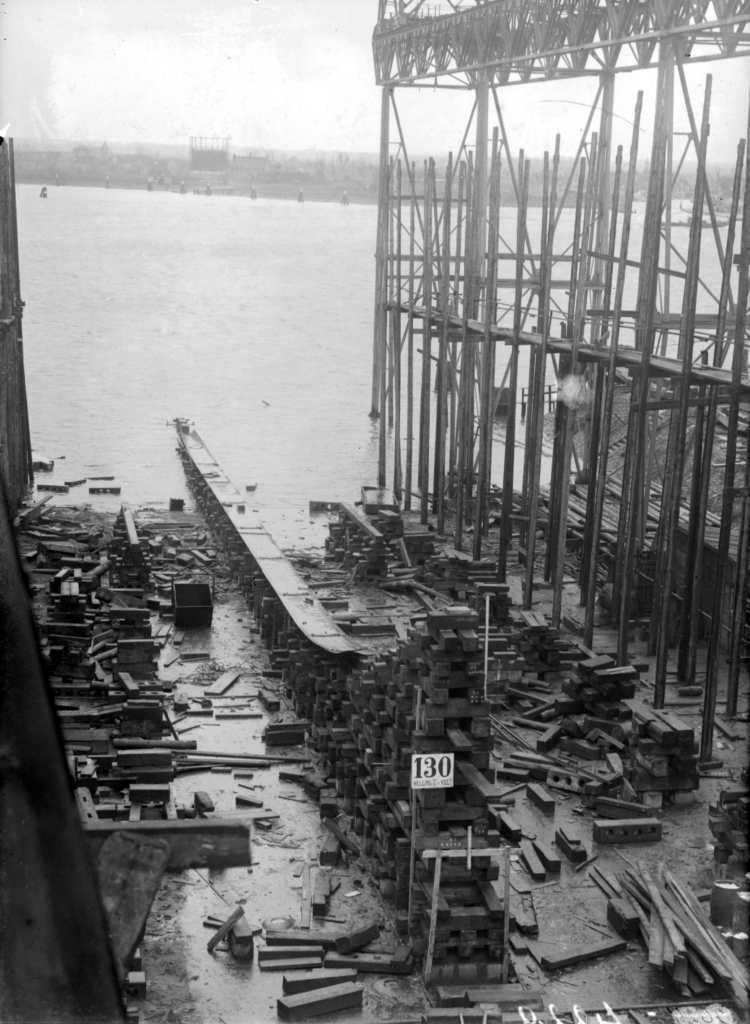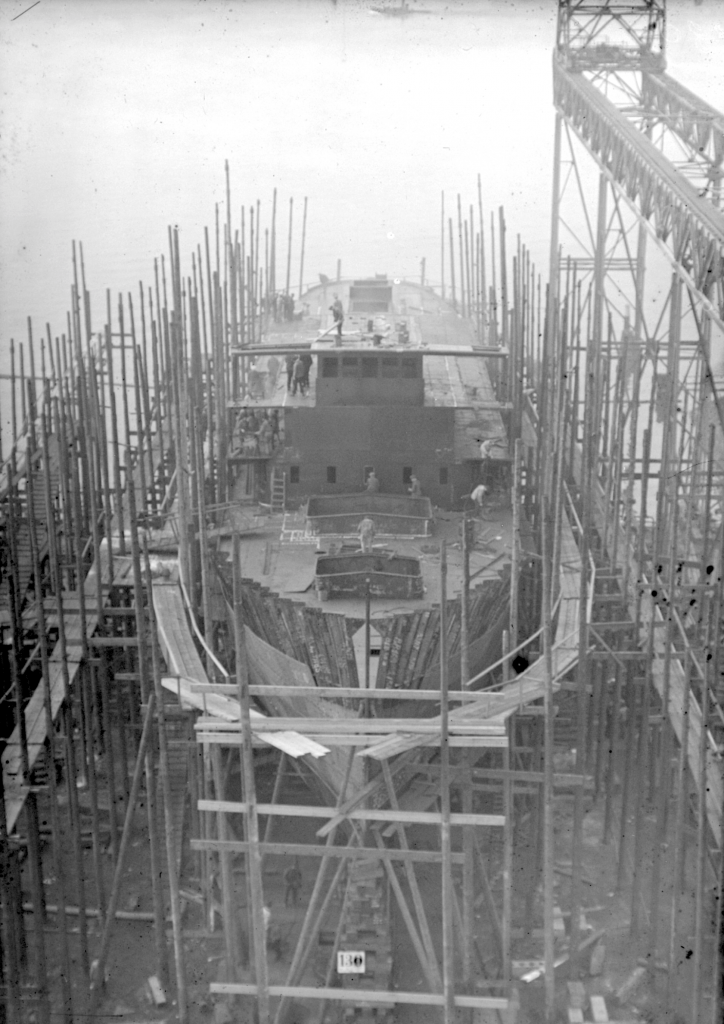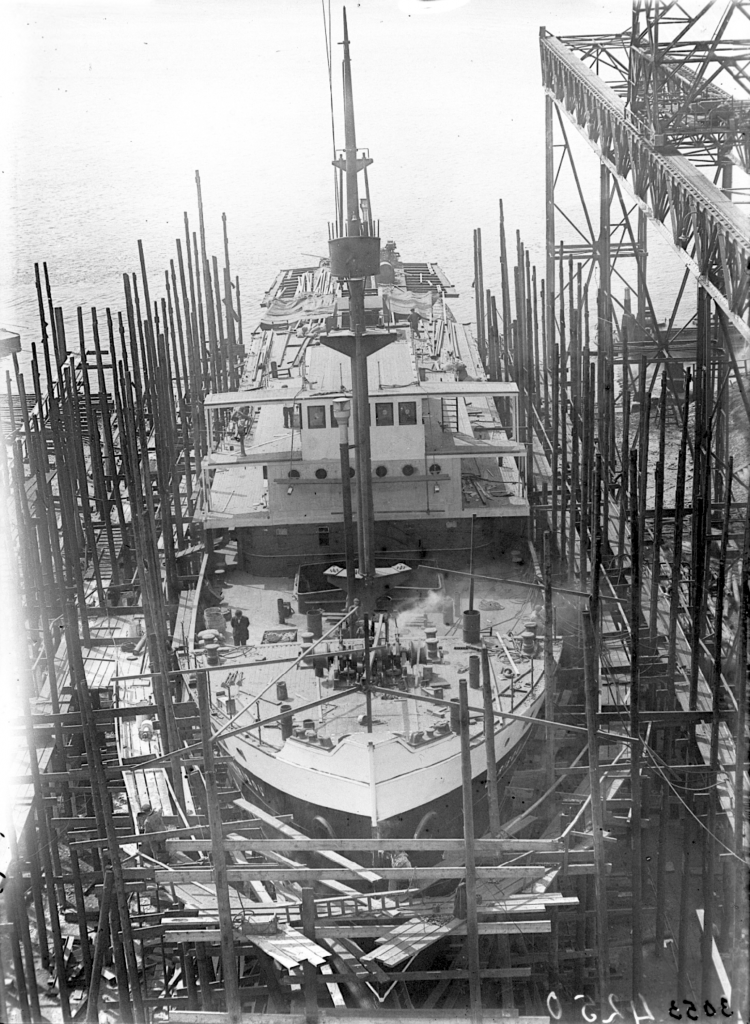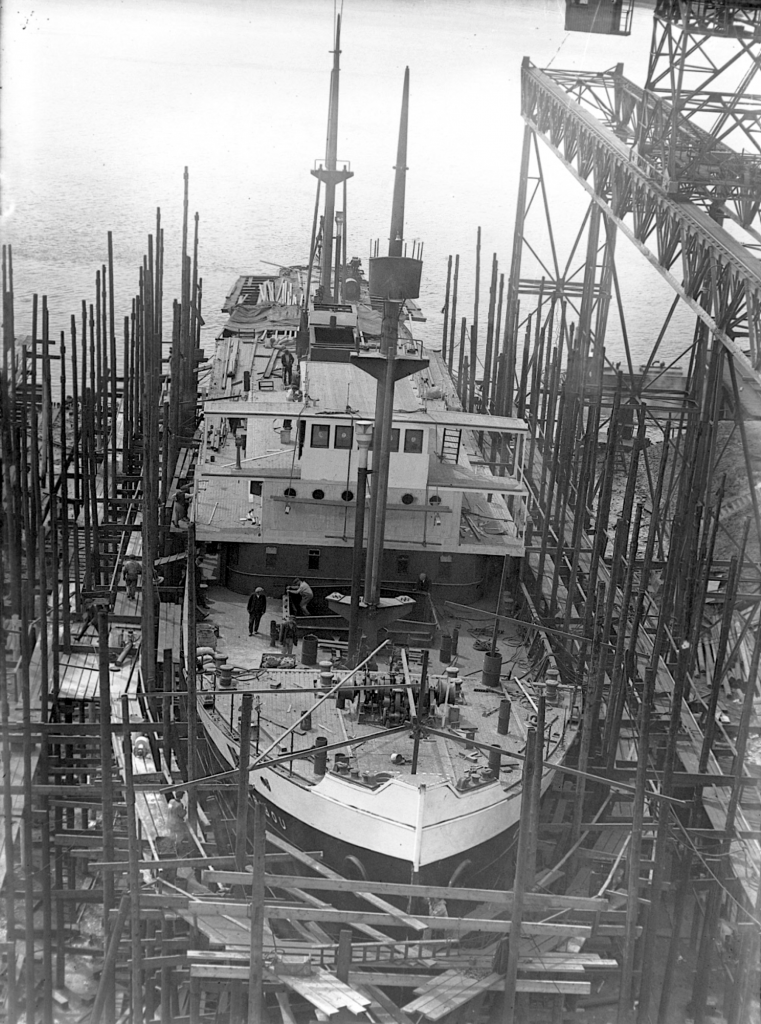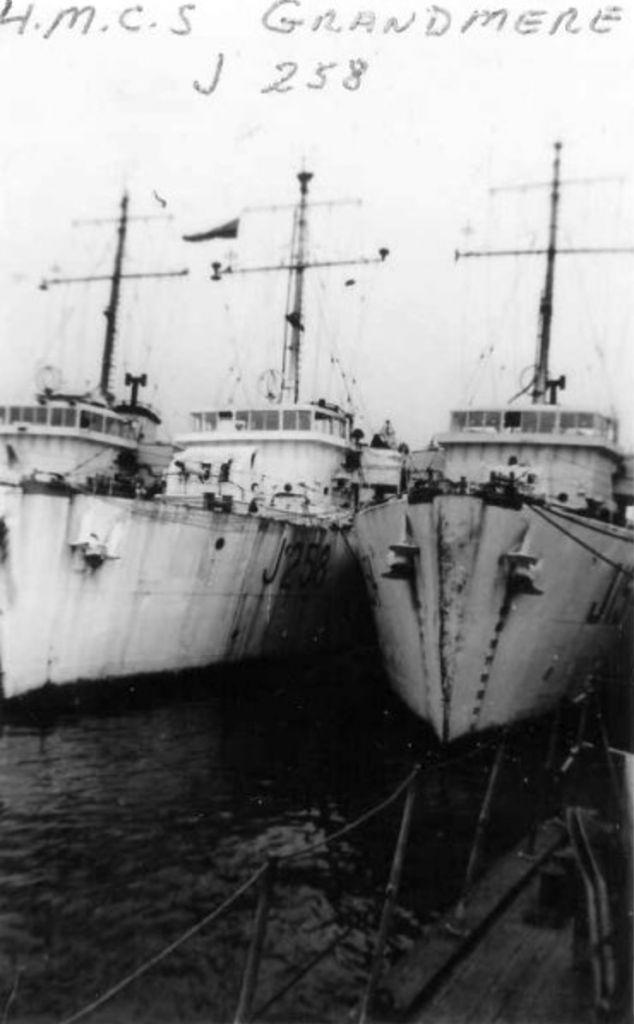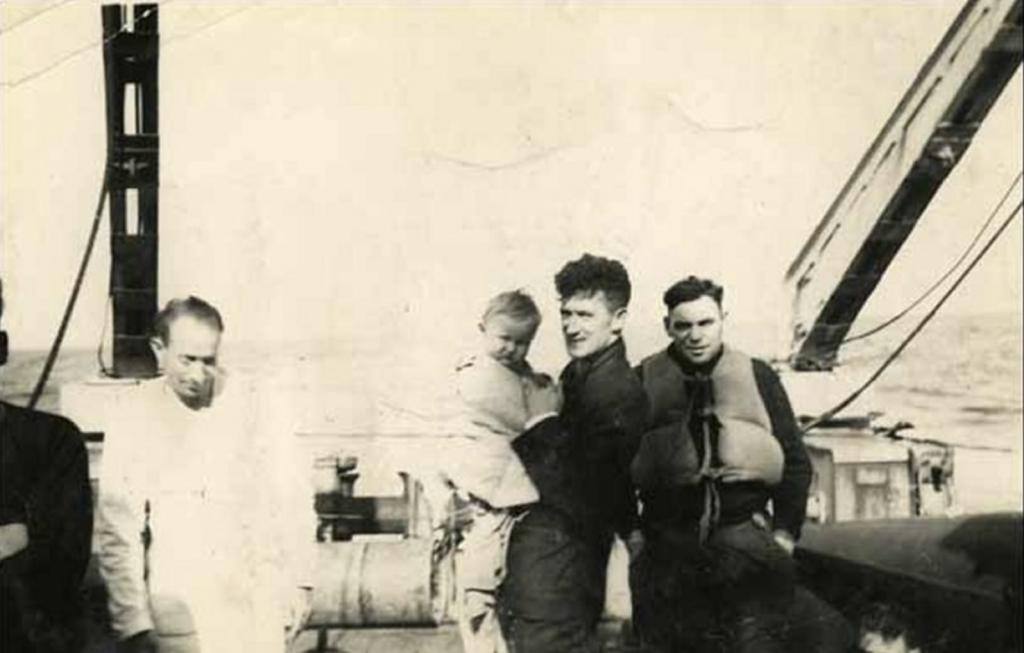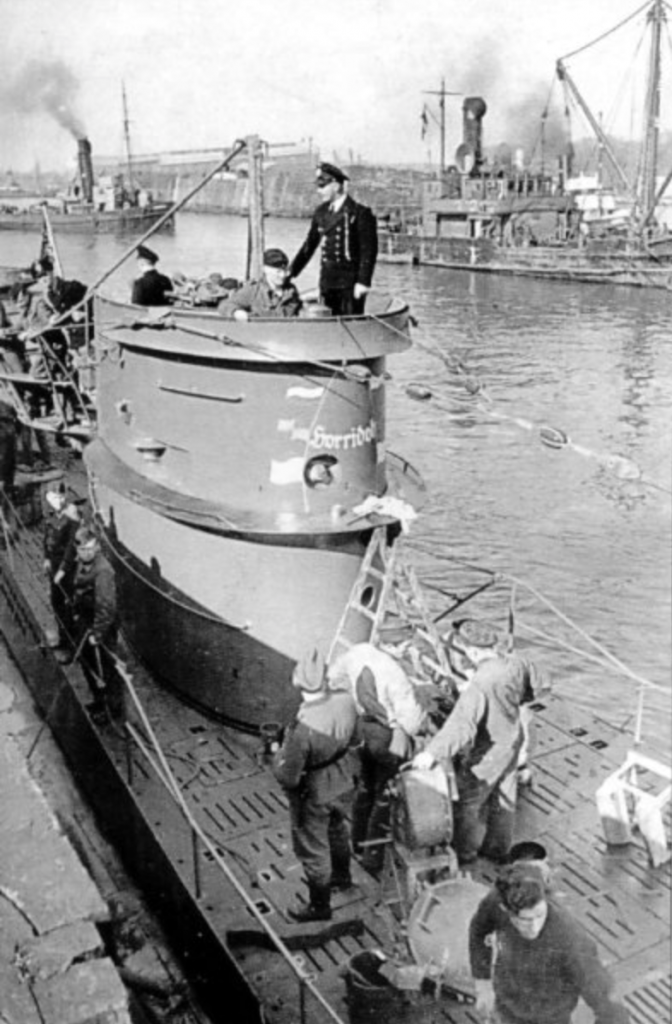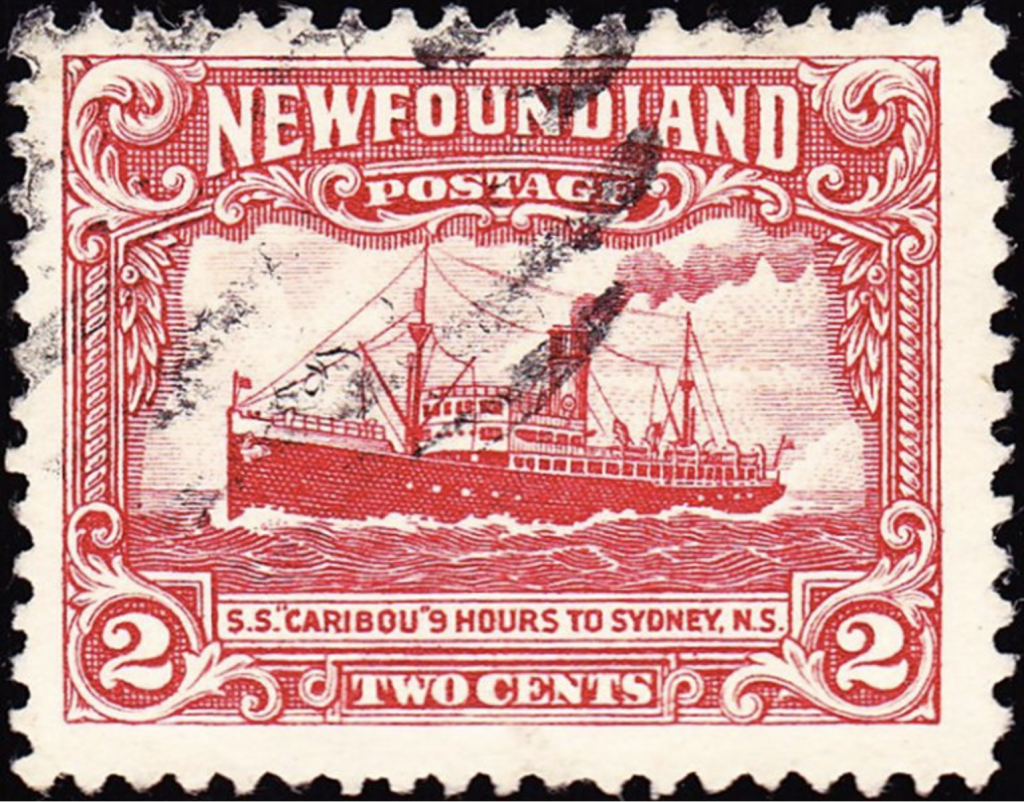Bouwnummer RDM-130, s.s. “Caribou”, 1925, vracht-passagiersschip.
Foto boven: Het s.s. “Caribou” van Newfoundland Government in 1926 in een droogdok.
Scheepswerf: NW.
Opdrachtgever: Newfoundland Government (Newfoundland Railway, ops.), St. John’s, Newfoundland.
Tonnage: 2222 brt, 1319 dwt, 3580 twvp.
Hoofdafmetingen: L = 80,80 m, B = 12,50 m, H = 7,80 m.
Voortstuwing: 2430 apk, snelheid 14 kn.
Verdere gegevens: Dit schip werd speciaal geconstrueerd en versterkt voor het varen in ijs.
Historie:
Opgeleverd in juni 1925.
Op 14-10-1942, tijdens een reis met passagiers van Sydney naar Port aux Basques, op positie 47°19′ NB en 59°29′ WL getorpedeerd door de Duitse onderzeeboot “U 69” en daarna gezonken. In totaal verloren 139 mensen hierbij hun leven.
Citaten:
– en.wikipedia.org:
… … SS “Caribou” was a passenger ferry used by the Newfoundland government’s ferry service between Port aux Basques, Newfoundland and North Sydney, Nova Scotia.
“Caribou” was built in 1925 at Rotterdam, Netherlands for the Newfoundland Railway. Launched in 1925, she had a capacity of 3,000 horsepower (2,200 kW) and was able to reach a speed of 14.5 knots (26.9 km/h) when fully loaded. She also had steam-heat and electric lights in all of her cabins, a luxury at the time. Due to her ice-breaking design, the Caribou also assisted during the seal hunt along the Newfoundland coast each spring.
“Caribou” was torpedoed by the German U-boat “U 69” and sunk in the Cabot Strait during the night of 14 October 1942. “Caribou” was carrying 46 crew and 206 civilian and military passengers. 137 lost their lives, many of them Newfoundlanders. Of the deceased, 2 were rescued but died of exposure. The remains of 34 victims were found. Only one of the eleven children survived. … …
– dieselduck.blogspot.com:
… … Sunday, February 17, 2008.
S.S. Caribou’s last surviving crew member dies, a bit of forgotten WWII history.
John Matthews served on ferry sunk by U-boat in 1942, by: CORY HURLEY, Corner Brook, Western Star.
A man believed to be the last living crew member and one of the last known survivors of a German U-boat attack on the the S.S. “Caribou” off Newfoundland in 1942, has died. John Matthews, 84, passed away in hospital last Thursday after years of lung-related complications.
“For me, as a child growing up, it wasn’t something he talked about a great deal,” his daughter, Diane Thistle, said in an interview. “He found it too painful, it was usually a teary subject and he tried to avoid it as much as possible.” At 19, Matthews was a deckwatch hand aboard the passenger ferry that ran between Port aux Basques, N.L., and North Sydney. In the early morning hours of Oct. 14, 1942, it was attacked by the German submarine “U 69”. A torpedo ripped a hole in the vessel, sinking it and sending all aboard into the frigid waters of the Cabot Strait. There were 137 casualties in one of the most devastating sea disasters off the coast of Newfoundland. The HMCS “Grandmere” rescued 101 passengers, crew, and military personnel after hours in the freezing water. Many survivors reported huddling in what was left of the over-filled lifeboats or rafts, fearing for their safety, or spending hours in the ocean clinging to some hope of rescue. The sinking was said to have erased the feelings of security that Newfoundlanders felt despite the war raging around the world. “It was a painful time. He was in the cold water for such a long time and so many of the people went down with the ship, and that was hard for him as well,” said Thistle. “I think his biggest sadness was the big loss of life, and the sounds he heard that night and remembered all his life.” Matthews related the story to family of how he woke his bunkmate and friend after the torpedo hit, but shortly afterwards realized they were separated. He never saw him again. However, he also told the story of pulling another survivor out of the water – W.J. Lundrigan, a well-known businessman and founder of the Lundrigan construction empire. After being rescued, the Port aux Basques native ended his career at sea but he stuck with the Newfoundland railway, spending 44 years as a conductor. With less than half of those aboard the S.S. “Caribou” surviving the disaster, Thistle said she has always felt lucky to have even been born. “I heard him say that there were so many of them in the lifeboat that they had to take turns getting out into the water and holding onto the boat so they didn’t sink it”, Thistle said. Over the years Matthews attended some of the events held in commemoration of the sinking. Diane and her husband are certain he was the last of the 46 crew living, but there is some uncertainty about how many survivors are still alive. … …
– www.lessignets.com:
… … Le 14 octobre 1942, une tragédie majeure survint au sud-ouest de Terre-Neuve. Le ferry SS Caribou, en route pour Port-aux-Basques, transportait 238 passagers (dont 24 femmes et 9 enfants), en plus de l’équipage de 15 personnes. De ces passagers, 117 étaient des soldats canadiens et américains. Tôt le matin du 14, à 25 milles de sa destination finale, le bateau fut frappé de plein fouet par une torpille qui traversa complètement la coque. Pas moins de 136 personnes furent tuées. La tragédie toucha tant de gens que le gouvernement canadien fut incapable d’étouffer l’affaire. Il décida donc de s’en servir comme outil de propagande pour manipuler l’opinion publique en faveur de l’effort de guerre. Le ministre MacDonald dénonça les méthodes «hideuses des Nazis» et déclara encore: “If there were any Canadians who did not realize that we were up against a ruthless and remorseless enemy, there can be no such Canadian now.”. … …
– www.wrecksite.eu, Lettens Jan, 22-01-2012:
… … CARIBOU.
On the 14th October 1942, CARIBOU, on voyage from North Sydney, Nova Scotia, Canada to Port aux Basques, Newfoundland with passengers, was torpedoad and sunk by the German submarine “U 69”, 25 miles south of Port Aux Basques off Cabot Strait. 136 people died.
Story:
CARIBOU (Capt. Taverner) was torpedoed by “U 69” (Kapitänleutnant Ulrich Gräf) while in convoy NL-9, on her regular run between Cape Breton and Newfoundland. Her escort, the minesweeper HMCS GRANDMERE had only short range asdic (sonar detection) and no radar.
GRANDMERE did not detect the submarine but sighted it after the attack, giving chase with depth charges as the submarine dove. “U 69″’s torpedo struck at 2:21 am hitting CARIBOU’s boilers. The explosion was very violent and the CARIBOU was ripped in two pieces. She sank in 5 minutes.
Survivors were left in overcrowded lifeboats and clinging to wreckage until dawn when GRANDMERE returned from its unsuccessful hunt for “U 69”. Only 101 of the 237 people aboard survived. 31 crew, 57 military and 48 passengers died.
Part of the passengers on board were women and children, who were heading to Nova Scotia to welcome a contingent of RCN sailors home from overseas. The sinking caused alarm in the Canadian and Newfoundland public about the vulnerability of the St. Lawrence to submarine attack. … …
Artikelen:
– Nieuwe opdrachten / Tewaterlating, Het Schip: 130-HS.pdf.
Films:
– YouTube
YouTube film van 4,1 minuten: The s.s. “Caribou” sunk on October 14th 1942, a loss of 136 lives.
– YouTube
YouTube film van 2,9 minuten: s.s.”Caribou”, Newfoundland Cabin Buoys, song.
Bronnen:
– Artikelen hierboven.
– 1902-1952, Een Halve Eeuw “Droogdok”, uitgegeven door de RDM op 23 januari 1952.
– “Rotterdamsche Droogdok Maatschappij” door Evert van der Schee, 1998, ISBN: 90 732 3516 2.
– Roel Zwama Rotterdam-Heijplaat.
– WikipediA
– The Monitor
– Wrecksite
